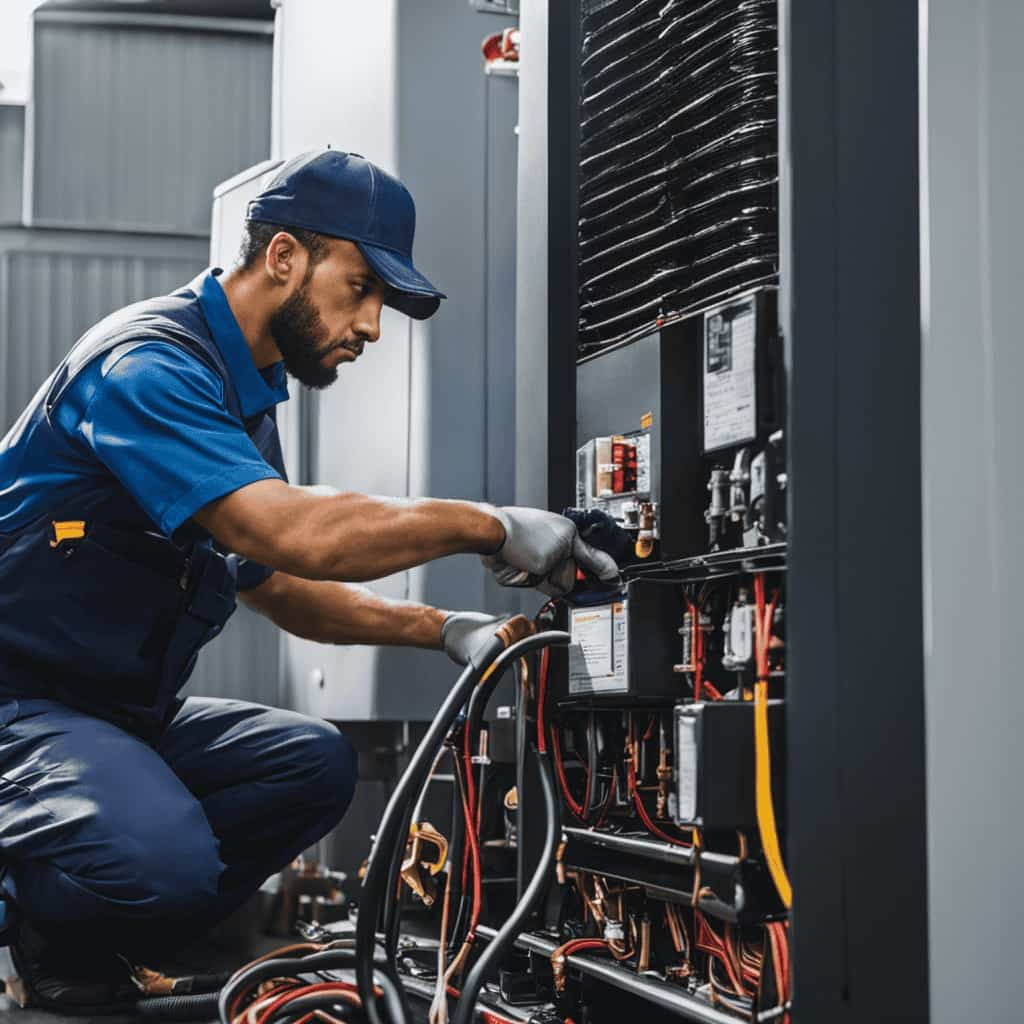We’re excited to show you the amazing technology that powers home geothermal heat pumps! These innovative devices use the Earth’s natural heat to efficiently heat and cool your home, saving you money and reducing your carbon footprint.
In this article, we’ll take you on a journey through the inner workings of geothermal heat pump technology, exploring the benefits, components, and design considerations.
Get ready to discover a whole new world of energy-efficient comfort!
Key Takeaways
- Geothermal heat pumps use the natural heat from the Earth to regulate home temperature.
- They provide energy cost savings by reducing reliance on traditional heating and cooling systems.
- Geothermal heat pumps produce fewer greenhouse gas emissions compared to conventional methods.
- Proper installation and regular maintenance are crucial for optimal system performance.
How Geothermal Heat Pump Technology Works
We will now explain how geothermal heat pump technology works.

When it comes to heating and cooling our homes, geothermal heat pumps offer an energy-efficient and environmentally friendly alternative. These systems use the natural heat from the earth to regulate the temperature inside our homes.
By tapping into the constant temperature of the ground, geothermal heat pumps can cool our homes in the summer and warm them in the winter. The process begins with a series of underground pipes, called the ground loop, which circulates a mixture of water and antifreeze.
This loop absorbs heat from the ground in the winter and transfers it into our homes, while in the summer, it extracts heat from our homes and releases it into the ground. This constant exchange of heat allows for efficient temperature control throughout the year.
Geothermal heat pump technology is a reliable and sustainable solution for our heating and cooling needs.

The Benefits of Residential Geothermal Heat Pumps
Let’s talk about the benefits of residential geothermal heat pumps.
One major advantage is the potential for energy cost savings. By using the constant temperature of the earth to heat and cool our homes, we can reduce our reliance on traditional heating and cooling systems, resulting in lower energy bills.
Additionally, geothermal heat pumps are an environmentally friendly option, as they produce fewer greenhouse gas emissions compared to conventional heating and cooling methods.
Energy Cost Savings
Using a residential geothermal heat pump can result in significant energy cost savings. We all want to save money on our energy bills, and a geothermal heat pump is a great way to do just that. With this technology, we can enjoy the comfort of a properly heated or cooled home while reducing our energy consumption.

By tapping into the constant temperature of the earth, geothermal heat pumps can provide efficient heating and cooling throughout the year. This means lower energy bills and more money in our pockets. Plus, with the added benefit of being environmentally friendly, we can feel good about our energy choices.
Environmentally Friendly Option
Residential geothermal heat pumps offer an environmentally friendly option, as they provide numerous benefits for both homeowners and the planet.
By harnessing the Earth’s natural heat, these systems reduce greenhouse gas emissions and dependence on fossil fuels. They require less electricity to operate compared to traditional heating and cooling systems, resulting in lower energy consumption and cost savings.
Additionally, geothermal heat pumps have a long lifespan and require minimal maintenance, reducing waste and environmental impact. The systems are also quiet, ensuring a peaceful living environment.

Furthermore, geothermal heat pumps can be combined with solar energy systems to further reduce carbon footprint.
Understanding the components of a geothermal heat pump system is essential to fully grasp the advantages and functionality of this eco-friendly and efficient technology.
Understanding the Components of a Geothermal Heat Pump System
Let’s now take a closer look at the key components of a geothermal heat pump system. Understanding how they contribute to its functioning is important for homeowners to make informed decisions about their systems.
The first component is the heat pump unit itself, which is responsible for transferring heat between the indoor and outdoor environments. It consists of a compressor, condenser, evaporator, and expansion valve. The compressor pressurizes the refrigerant, the condenser releases heat to the indoor space or the ground, the evaporator absorbs heat from the indoor space or the ground, and the expansion valve controls the flow of refrigerant.

The second component is the ground loop system, which consists of pipes buried underground. These pipes are filled with a heat transfer fluid, typically a mixture of water and antifreeze. The ground loop system is responsible for transferring heat to and from the ground. There are three main types of ground loop systems: horizontal, vertical, and pond/lake loops.
The third component is the distribution system, which circulates the conditioned air or water throughout the building. For forced air systems, this typically includes ductwork and air handlers. For radiant floor heating systems, this includes a network of pipes embedded in the floor. The distribution system ensures that the desired temperature is achieved in each room or area of the building.
Proper installation is crucial for the effective operation of a geothermal heat pump system. It involves determining the optimal size and location for the ground loop system, as well as ensuring that the heat pump unit and distribution system are properly connected and calibrated. Incorrect installation can result in reduced efficiency and performance.
Regular maintenance is also important to keep the system running smoothly and efficiently. This includes checking and cleaning the air filters, inspecting the ground loop system for leaks or damage, and ensuring that the heat pump unit is functioning properly. Regular maintenance can extend the lifespan of the system and prevent costly repairs.

Key System Components
Examining the various components, we can gain a better understanding of how a geothermal heat pump system operates.
The key components of a geothermal heat pump system include the heat pump unit, the ground loop system, and the distribution system.
The heat pump unit is the heart of the system, responsible for transferring heat between the indoor and outdoor environments. It consists of a compressor, condenser, evaporator, and refrigerant.
The ground loop system consists of pipes buried in the ground that circulate a mixture of water and antifreeze. These pipes absorb heat from the ground during the heating season and release heat into the ground during the cooling season.

The distribution system, which includes ductwork or radiant floor heating, distributes the heated or cooled air throughout the home.
Installation and Maintenance?
We will now explore the installation and maintenance of a geothermal heat pump system, focusing on the key components and their functions. To help you better understand this topic, let’s take a look at a table that outlines the main components of a geothermal heat pump system and their respective functions:
| Component | Function |
|---|---|
| Heat Pump Unit | Transfers heat between the ground and the home, providing heating and cooling. |
| Ground Loop System | Circulates a fluid (usually water or antifreeze) through underground pipes to exchange heat with the ground. |
| Distribution System | Distributes heated or cooled air throughout the home using ductwork or radiant flooring. |
Proper installation and regular maintenance of these components are crucial for the optimal performance and longevity of a geothermal heat pump system. It is recommended to consult a professional HVAC technician to ensure the system is installed correctly and to schedule routine maintenance to keep it running efficiently.
Types of Geothermal Heat Pump Systems for Residential Use
There are three main types of geothermal heat pump systems commonly used for residential heating and cooling.

The first type is the horizontal loop system, which involves burying pipes horizontally in trenches. This system is ideal for areas with ample space available.
The second type is the vertical loop system, where pipes are installed vertically in boreholes. This system is suitable for areas with limited space.
Finally, there’s the pond/lake loop system, which utilizes a body of water as a heat source or sink. This system is ideal for properties with access to a pond or lake.
Each type of system has its own advantages and considerations, so it’s important to consult with a professional to determine which option is best suited for your specific needs and property.

Sizing and Design Considerations for Geothermal Heat Pump Systems
When sizing and designing geothermal heat pump systems, there are several key points to consider.
First, it’s important to determine the optimal system size based on the heating and cooling needs of the building.
Additionally, efficient design strategies such as proper insulation and air sealing can greatly improve the performance of the system.
Lastly, an environmental impact assessment should be conducted to ensure that the chosen system aligns with sustainability goals.

Optimal System Size
To achieve optimal system performance, it’s essential to carefully consider the size and design of geothermal heat pump systems. Here are three key factors to keep in mind when determining the optimal system size for your residential geothermal heat pump:
Heat Load Calculation: Conduct a thorough assessment of your home’s heating and cooling needs to determine the appropriate system capacity. Factors such as insulation levels, window efficiency, and climate conditions must be taken into account.
Ground Loop Sizing: The size of the ground loop, which is responsible for transferring heat between the earth and the heat pump, should be proportionate to the system’s capacity. An undersized loop may result in reduced efficiency, while an oversized loop can lead to unnecessary costs.
Equipment Selection: Choose a heat pump unit that matches your home’s requirements. An oversized system will cycle on and off frequently, resulting in decreased efficiency and increased wear and tear.

By carefully considering these factors, you can ensure that your geothermal heat pump system is appropriately sized for optimal performance.
Now let’s explore efficient design strategies to maximize its efficiency.
Efficient Design Strategies
After carefully determining the optimal system size, we can now explore efficient design strategies to maximize the efficiency of our geothermal heat pump system. By implementing these strategies, we can ensure that our system operates at its full potential, providing us with the desired comfort and energy savings.
One important consideration is the placement of the heat pump system. It’s best to install it in a location with good air circulation and minimal obstructions. This will allow for efficient heat transfer and prevent any unnecessary strain on the system.

Additionally, proper insulation is crucial for minimizing heat loss and maximizing energy efficiency. By insulating our home effectively, we can reduce the workload on the geothermal heat pump and achieve optimal performance.
Furthermore, incorporating zoning systems can optimize energy usage by allowing us to control the temperature in different areas of our home independently. This way, we can avoid heating or cooling unused spaces, saving energy and reducing our utility bills.
Lastly, regular maintenance and servicing of our geothermal heat pump system are essential. This ensures that the system operates efficiently and prolongs its lifespan.
Environmental Impact Assessment
We need to consider the sizing and design of geothermal heat pump systems in order to assess their environmental impact. Here are three important factors to consider:

Heat load calculation: Properly sizing the system involves determining the heat load of your home. This includes factors such as insulation levels, building orientation, and window efficiency. By accurately calculating the heat load, you ensure that the geothermal system is sized appropriately, resulting in optimal energy efficiency.
Ground loop design: The design of the ground loop system is crucial for the overall performance of the geothermal heat pump. Factors such as soil type, available land area, and depth of the ground loop all need to be considered. A well-designed ground loop ensures efficient heat exchange with the earth, reducing the system’s environmental impact.
Equipment selection: Choosing the right components for your geothermal system is essential. From the heat pump unit to the distribution system, each component should be selected based on energy efficiency and environmental impact. By selecting high-quality, energy-efficient equipment, you can further minimize the environmental footprint of your geothermal heat pump system.
Considering these sizing and design considerations will help minimize the environmental impact of geothermal heat pump systems, making them a more sustainable choice for residential heating and cooling.

Installation Process for Residential Geothermal Heat Pumps
We begin the installation process for residential geothermal heat pumps by conducting a thorough site assessment. This involves evaluating the property’s geological characteristics, such as soil type and groundwater availability, to determine the most suitable system design.
Once the site assessment is complete, we proceed with drilling boreholes or installing horizontal trenches, depending on the available space. These boreholes or trenches are used to house the geothermal loops, which circulate the heat transfer fluid between the ground and the heat pump.
The next step is installing the heat pump unit inside the home, typically in the basement or utility room.
Lastly, we connect the geothermal loops to the heat pump and test the system to ensure proper functionality. Throughout the installation process, we prioritize clear communication and collaboration with homeowners to ensure a smooth and efficient experience.

Maintenance and Troubleshooting Tips for Geothermal Heat Pump Systems
To ensure optimal performance and longevity of geothermal heat pump systems, it’s important to regularly maintain and troubleshoot them. Here are some maintenance and troubleshooting tips that can help you keep your system running smoothly:
Schedule regular professional maintenance: It’s recommended to have a professional technician inspect and service your geothermal heat pump system at least once a year. They can check for any issues, clean the filters, and ensure that everything is working properly.
Keep the filters clean: Regularly clean or replace the filters in your system to prevent dirt and debris from clogging the system and reducing its efficiency.
Monitor the thermostat: Make sure your thermostat is set at the desired temperature and functioning correctly. If you notice any issues, such as temperature fluctuations, it may be a sign of a problem with the system.

By following these maintenance and troubleshooting tips, you can ensure that your geothermal heat pump system operates efficiently and effectively.
Now, let’s compare geothermal heat pumps to traditional heating and cooling systems.
Comparing Geothermal Heat Pumps to Traditional Heating and Cooling Systems
Geothermal heat pumps offer numerous advantages over traditional heating and cooling systems.
With geothermal heat pumps, we can enjoy more consistent and comfortable temperatures in our homes throughout the year. Unlike traditional systems, geothermal heat pumps don’t rely on fossil fuels, reducing our carbon footprint and helping us contribute to a cleaner environment.

They also provide a more efficient way of heating and cooling, resulting in lower energy bills and cost savings over time. Additionally, geothermal heat pumps are quieter and require less maintenance compared to traditional systems.
By choosing geothermal heat pump technology, we can experience the benefits of a more sustainable and efficient heating and cooling solution for our homes.
Now, let’s dive into the details of energy efficiency and cost savings with geothermal heat pump technology.
Energy Efficiency and Cost Savings With Geothermal Heat Pump Technology
By utilizing geothermal heat pump technology, homeowners can experience significant energy efficiency and cost savings. Here are three ways that geothermal heat pumps can help you save money and reduce your energy consumption:

Lower energy bills: Geothermal heat pumps use the constant temperature of the ground to heat and cool your home, which allows them to operate more efficiently than traditional HVAC systems. This means lower energy consumption and lower utility bills for you.
Reduced maintenance costs: Geothermal heat pumps have fewer moving parts compared to traditional systems, which means there’s less chance of mechanical failure and costly repairs. With proper maintenance, geothermal systems can last for decades, providing long-term savings.
Tax incentives and rebates: Many governments and utility companies offer incentives and rebates for homeowners who install geothermal heat pump systems. These financial incentives can help offset the initial installation costs and provide additional savings.
Environmental Impact of Residential Geothermal Heat Pump Systems
Over time, we can see the positive environmental impact of using residential geothermal heat pump systems. These systems use the earth’s natural heat to provide heating, cooling, and hot water for homes. By harnessing this renewable energy source, geothermal heat pumps help reduce greenhouse gas emissions and dependence on fossil fuels.

They don’t release any harmful pollutants into the air, making them a clean and sustainable option for heating and cooling. Additionally, geothermal systems require less electricity to operate compared to traditional heating and cooling systems, resulting in lower energy consumption and reduced carbon footprint.
Frequently Asked Questions
Are Geothermal Heat Pump Systems Suitable for All Types of Residential Buildings?
Yes, geothermal heat pump systems are suitable for all types of residential buildings. They provide efficient heating and cooling by utilizing the stable temperature of the earth, making them a great option for homes.
How Long Does It Take to Install a Residential Geothermal Heat Pump System?
It takes a few weeks to install a residential geothermal heat pump system. We can handle the entire process, from assessing your property to drilling and connecting the system.
Can a Geothermal Heat Pump System Be Used for Both Heating and Cooling in a Residential Setting?
Yes, a geothermal heat pump system can be used for both heating and cooling in a residential setting. It’s a versatile technology that harnesses the earth’s constant temperature to provide year-round comfort and energy efficiency.

Are Geothermal Heat Pumps Noisy When Operating in a Residential Setting?
Yes, they can be a bit noisy at times, but it’s usually just a low hum that blends into the background. Overall, geothermal heat pumps are a quiet and efficient option for residential heating and cooling.
What Are the Potential Drawbacks or Limitations of Using a Geothermal Heat Pump System in a Residential Setting?
There can be some potential drawbacks or limitations when using a geothermal heat pump system in a residential setting. These may include higher upfront costs, the need for proper insulation, and the availability of suitable ground or water sources for heat exchange.
Can Geothermal Heat Pump Technology be Used in Residential Settings?
Geothermal heat pump technology simplified can indeed be utilized in residential settings. This innovative system harnesses the natural heat from the earth’s core to provide heating, cooling, and even hot water. By using a series of pipes underground, geothermal heat pumps efficiently transfer heat, making them an eco-friendly and cost-effective solution for homeowners.
Conclusion
In conclusion, residential geothermal heat pump technology offers numerous benefits, including energy efficiency, cost savings, and environmental sustainability.
These systems work like a natural ‘thermal battery,’ drawing heat from the earth to provide heating and cooling for homes.

With proper sizing, design, and maintenance, geothermal heat pump systems can effectively replace traditional heating and cooling systems, reducing reliance on fossil fuels and minimizing carbon emissions.
It’s like tapping into a limitless underground reservoir of energy to create a comfortable and sustainable home environment.









